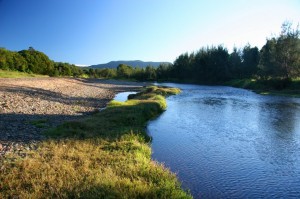In our current state of environmental crisis, biodiversity assessment is critical to understanding the rapid ecological changes taking place across the globe. In the last ten years, there has been a strong emergence of non-invasive monitoring involving auditory recordings of the environment. This emerging field is commonly referred to as soundscape ecology and shares many parallels with other fields, including bioacoustics. Soundscape ecology has an array of creative possibilities that have been deeply explored by practitioners including Bernie Krause. The literature suggests it will continue expanding within scientific fields, with a particular focus on the importance of soundscape conservation, the impact of noise pollution, and the value of soundscapes to assist with biodiversityanalysis. There are now a growing number of international projects and scientific institutions embracing methods of bioacoustics in biodiversity analysis of aquatic environments.
River Listening is a practice-led interdisciplinary collaboration of freshwater biodiversity, virtual technologies, soundscape ecology and environmental sound art to explore methods of hydrophonic recording, soundscape analysis and virtual dissemination. Despite the rapidly growing interest in emerging auditory fields such as bioacoustics, there is yet to be standardised approaches to field recording and interpreting the data. While scientists have developed advanced software tools for species recognition, there is a growing need to consolidate the available tools and explore the value of listening to the data in new ways. There are also exciting possibilities to make this data available for a wider audience through digital technology and creative collaborations.

The River Listening Synapse residency specifically involves field labs on the identified rivers experimenting with various hydrophonic recording techniques and sound processing. The labs each involve a three-week immersive engagement process, which is based on a methodology developed during my doctoral research. The labs involve three daily recording sessions; sunrise, midday and dusk. Each recording session is approximately two hours, with a custom-made quadrophonic hydrophone rig attached to a moving kayak. These recordings are databased onsite, and made available online for analysis at the Australian Rivers Institute.
In addition to the kayak recordings, other field kits are distributed on location to capture sounds without human intervention. These include a stationary hydrophone that records from the same location during the entire field lab and a series of smaller field kits to capture the soundscapes above the water. The additional field kits are useful to analyse particular sound sources in the hydrophone recordings that might be difficult to identify. The recording sessions are accompanied by community workshops and creative development experiments involving streaming and processing the hydrophone recordings. The team will facilitate a range of community events and will also collaborate with existing programs in each river community.
The field labs are designed in an open format and encourage collaborations with the local community. The future outcomes will be made available through a virtual sound map and public listening sessions in Queensland, Australia. The database of recordings will form the foundation for a series of experiments at the Australian Rivers Institute to explore new methods in understanding and analysing the data from a scientific and creative perspective.
I’m thrilled to have the opportunity to collaborate with The Australian Rivers Institute (ARI) on River Listening. The Australian Rivers Institute is Australia’s largest university aquatic ecosystem research group with globally recognised expertise in river, catchment and coastal ecosystems. ARI is currently leading a range of innovative projects revolving around catchment and river ecosystem processes, aquatic biodiversity and conservation, and aquatic ecosystem monitoring and assessment.
While I’m working with several researchers at ARI, the scientific grounding of the River Listening collaboration is directed by ARI Senior Research Fellow Dr Simon Linke, one of Australia’s leading freshwater conservation scientists, whose pioneering work in biomonitoring and river conservation planning has been used by agencies and NGOs from South East Queensland to the Congo. Simon has a strong interest in bioacoustics and was introduced to me Dr Toby Gifford, a music technologist from the Queensland Conservatorium of Music. Dr Gifford is a world-leader in real-time audio processing, machine listening and automated musical scene description who has worked with the ARI to explore future frameworks for a real-time bioacoustic wildlife population monitoring network for Australian waterways. We hope some of the results from River Listening can be incorporated into the broader aquatic bioacoustics visions of ARI in the future.
As the international interest in the emerging auditory fields of bioacoustics and acoustic ecology continues to expand, there are clear opportunities to harness virtual technologies to develop accessible community engagement around the creative and scientific possibilities of listening to the environment. River Listening provides a model to develop a truly interdisciplinary approach at the critical stage of creative development and it is anticipated the future results will be beneficial to national ecosystem monitoring programs. I also hope that River Listening could become a catalyst for community engagement and interdisciplinary thinking at a time when the conservation and management of aquatic ecosystems is a critical priority. At the conclusion of the River Listening labs in Queensland, the research team hope to expand this project across Australia and beyond.
